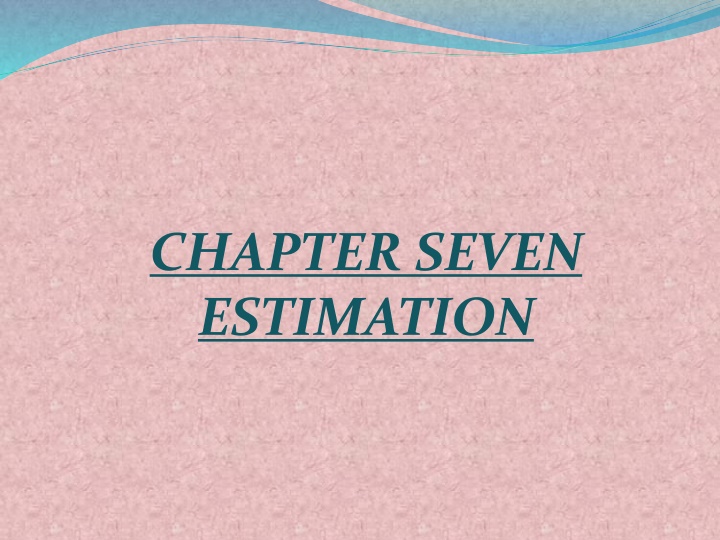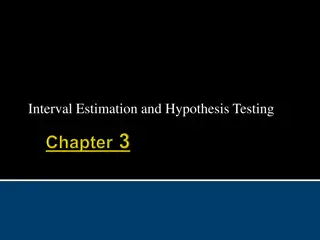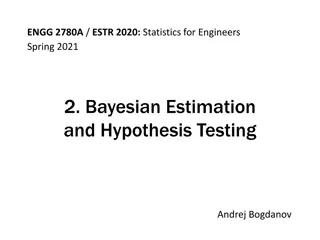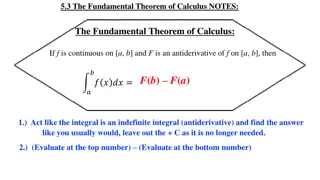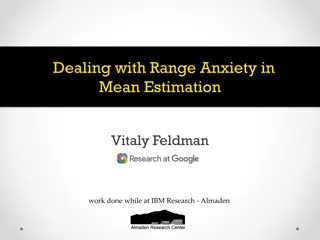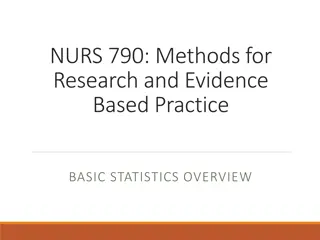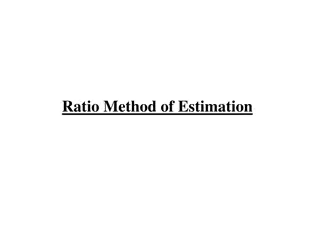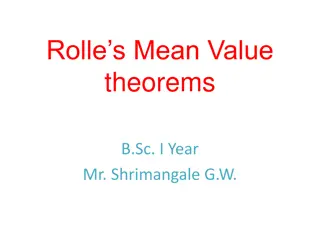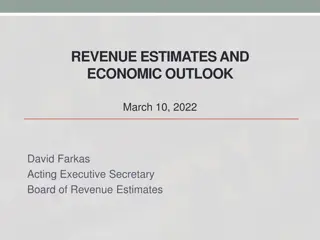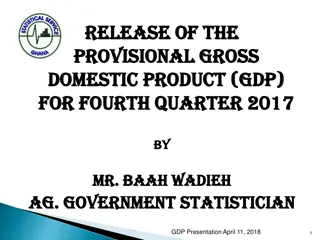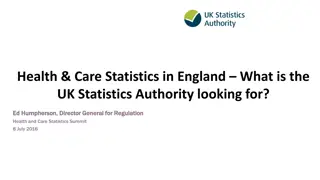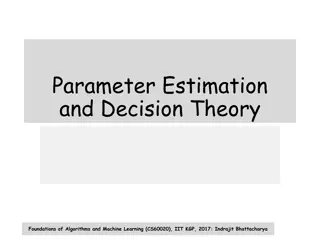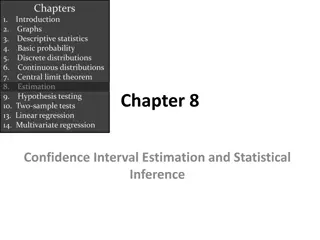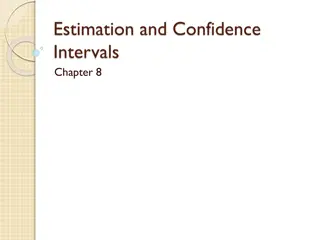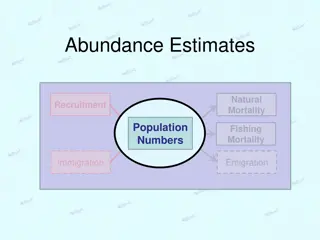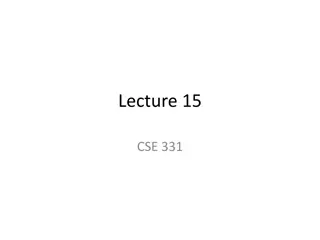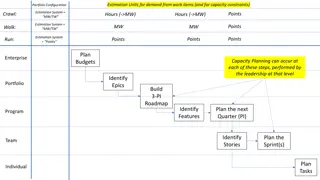Estimation in Statistics: Point and Interval Estimates
In statistics, estimation involves determining the value of unknown population parameters based on sample data. Point estimates provide single values as estimates, while interval estimates give ranges within which the true parameter is likely to lie. This chapter delves into the concepts of point and interval estimates, providing insights into how statistical estimators work and how confidence intervals are constructed.
Download Presentation

Please find below an Image/Link to download the presentation.
The content on the website is provided AS IS for your information and personal use only. It may not be sold, licensed, or shared on other websites without obtaining consent from the author.If you encounter any issues during the download, it is possible that the publisher has removed the file from their server.
You are allowed to download the files provided on this website for personal or commercial use, subject to the condition that they are used lawfully. All files are the property of their respective owners.
The content on the website is provided AS IS for your information and personal use only. It may not be sold, licensed, or shared on other websites without obtaining consent from the author.
E N D
Presentation Transcript
CHAPTER SEVEN ESTIMATION
7.1 A Point Estimate: A point estimate of some population parameter is a single value of a statistic (parameter space). For example of the statistic computed from a sample of size n is a point estimate of the population parameter .Similarly is a point estimate of the true proportion for a binomial experiment. is an estimator of the population parameter , but the value of is an estimate of . The statistic that one uses to obtain a point estimate is called an estimator or a decision function. x X p = n x P x
n 1( = 2 ) X X i Hence the decision function which is a function of the random sample is an estimator of the population variance , .The single numerical value that results from evaluating this formula is called an estimate of the parameter, . An estimator is not expected to estimate the population parameter without error. = 2 S i 1 n
7.2 Interval Estimate: An interval estimate of a population parameter is an interval of the form where and depend on the value of the statistic for a particular sample and also on the sampling distribution of .Since different samples will generally yield different values of and therefore different values of and . From the sampling distribution of we shall be able to determine and such that the is equal to any positive fractional value we care to specify. If for instance we find and such that: L L U U U L L U ( ) P L U L U
( = ) 1 0 1 P for L U (1 ) , then we have a probability of of selecting a random sample that will produce an interval containing . The interval computed from the selected sample, is then called a confidence interval, the fraction is called confidence coefficient or the degree of confidence and the end points and are called the lower and upper confidence limits. Thus when we have a confidence interval and so on, that we are confident that is between , % 95 L (1 U (1 ) )100% L U = . 0 05 95 % U L
7.3 Estimating the Mean: 7.3.1 Confidence Interval of when is Known: --------------------------------------------------------------- If is the mean of a random sample of size n from a population with known variance , a confidence interval for is given by: X 100 ) 1 ( % + (1) X Z X Z 1 /2 1 /2 n n Z where is the-value leaving an area of to the right. , L X Z n 1 / 2 2 = = + (2) X Z 1 /2 1 /2 U n
EX (1): The mean of the quality point averages of a random sample of 36 college seniors is calculated to be 2.6. Find the confidence intervals for the mean of the entire senior class. Assume that the population standard deviation is 0.3. 95 %
Solution: = = = 36 , 2.6 , 0.3 n X confidence interval for the mean : ------------------------------------------------- At 1 0.95 0.05 2 95 % = = = = 0.025 1.96 Z 1 2 X Z n 1 2 0.3 36 2.6 (2.57)( ) 2.6 0.1285 = 2.4715 2.7285 (2.4715 2.7285) 0.99 P Thus,we have 95% confident that lies between 2.4715,2.7285
Theorem (1): If is used as an estimate of , we can then be confident that the error will not be exceed . For example (1): e= (1.96) (0.3/6)=0.098 or e = (2.57) (0.3/6) = 0.1285 Theorem (2): If is used as an estimate of , we can be confident that the error will not exceed a specified amount, when the sample size is: e Z n e 100 ) 1 ( % X Z n 1 2 100 ) 1 ( % X 2 1 = (3) 2 The fraction of n is rounded up to next whole number.
EX (2): How large a sample is required in Ex. (1) if we want to be confident that our estimate of is off by less than 0.05 (the error is 0.05)? Solution 0.05 0.025 2 95 % = = = 1.96, Z 1 2 = = 0.3 , 0.05 e 2 (1.96)(0.3) 0.05 = = 138.2976 138 n n is rounded up to whole number.
7.3.2 Confidence Interval of when is Unknown n<30 : If and are the mean and standard deviation of a random sample from a normal population with unknown variance , a confidence interval for is given by: S X 100 ) 1 ( % S S + (4) X t X t n n 1 , 1 1 , 1 n n 2 2 t where is the value with n-1 degrees of freedom leaving an area of to the right. 2 1 2
EX (3): The contents of 7 similar containers of sulfuric acid are 9.8, 10.2, 10.4, 9.8, 10, 10.2, 9.6 liters. Find a confidence interval for the mean of all such containers assuming an approximate normal distribution. 95 %
Solution: confidence interval for the mean : ------------------------------------------------ = = = 7 , 10 , 0.283 , n X S = = = = = = :1 0.95 0.05 0.025 2.447 at t t t 0.025,6 0.975 , 6 2 1 , 1 n 2 0.283 S 10 (2.447)( 10 0.262 ( ) ) X t 7 n 1 , 1 n 2 = 9.738 10.262 (9.738 10.262) 0.95 P
7.4 Estimating the Difference between Two Means: and 2 1 2 2 7.4.1 Confidence Interval for when Known: ----------------------------------------------------------------- If are the means of independent random samples of size n1and n2 from populations with known variances respectively, a confidence interval for is given by: 1 1 2 X and X 1 2 2 1 2 2 and 100 ) 1 ( % 2 2 1 2 2 + ( ) (5) X X Z 1 2 n n 1 1 2 2 Z where is the-value leaving an area of to the right . 2 1 2
EX (4): A standardized chemistry test was given to 50 girls and 75 boys. The girls made an average grade of 76, while the boys made an average grade of 82. Find a confidence interval for the difference where is the mean score of all boys and is the mean score of all girls who might take this test. Assume that the population standard deviations are 6 and 8 for girls and boys respectively. 96 % 1 1 2 2
Solution: girls Boys n = n = 50 75 1 2 X = X = 76 82 1 2 = = 6 8 1 2 confidence interval for the mean : ----------------------------------------------------- 96% 1 2 = = = = 1 0.94 0.04 0.02 2.05 Z 2 1 2 2 1 2 2 + ( ) X X Z 1 2 n n 1 1 2 2 36 50 64 75 + (82 76) (2.05) 6 2.571 = 3.429 8.571 (3.429 8.571) 0.96 P 1 2 1 2
2 1 2 2 7.4.2 Confidence Interval for when Unknownbut equal variances: and 1 2 are the means of independent random samples of size n1and n2 respectively from approximate normal populations with unknown but equal variances, a confidence interval for is given by: 1 ( ) P v n X and X 1 2 100 ) 1 ( % 1 2 1 n + (6) X X t S 1 2 1 , , where 1 2 2 + 2 2 2 ( 1) n ( 1) n S n S = (7) S 1 1 + 2 P 2 n 1 2 is the pooled estimate of the population standard deviation and is the t value with degrees of freedom leaving an area of to the right. = + t 2 v n n 1 2 1 , v 2 2
EX (5): The independent sampling stations were chosen for this study, one located down stream from the acid mine discharge point and the other located upstream. For 12 monthly samples collected at the down stream station the species diversity index had a mean value and a standard deviation while 10 monthly samples had a mean index value and a standard deviation . Find a 90% confidence interval for the difference between the population means for the two locations, assuming that the populations are approximately normally distributed with equal variances. 1= . 3 11 X 1= . 0 771 S 2= . 2 04 X 2= . 0 448 S
Solution: Station 1 Station 2 n = 12 n = 10 1 2 X = X = S = 2.04 3.11 0.771 2 1 S = 0.448 1 2 90% confidence interval for the mean : 1 2 + 2 2 11(0.771) 9(0.448) 2 = = 0.646 S P 12 10 + = = = = 1 0.90 0.1 0.05 1.725 at t t 0.95 , 20 2 + 1 , 2 n n 1 2 2 1 1 (3.11 2.04) + (1.725)(0.646) 1.07 0.477 12 10 = 0.593 1.547 (0.593 1.547) 0.90 P 1 2 1 2
7.5 Estimating a Proportion: 7.5.1 Large Sample Confidence Interval for P: p If is the proportion of successes in a random sample of size n and an approximate confidence interval for the binomial parameter is given by: 1 2 n = 100 ) q p 1 1 ( % pq p (8) Z Where is the Z- value leaving an area of to the right. Z 2 1 2
EX(7): A new rocket launching system is being considered for deployment of small, short rang rockets. The existing system has p=0.8 as the probability of a successful launch. A sample of 40 experimental launches is made with the new system and 34 are successful. Construct a 95% confidence interval for p .
Solution: a 95% confidence interval for p . 34 40 = = = = p 40 , 0.85 , 0.15 n q = = = = 1 0.95 0.05 0.025 1.96 at Z 2 1 2 pq n (0.85)(0.15) 40 p 0.85 (1.96) 0.85 (0.111) Z 1 2 = 0.739 0.961 (0.739 0.961) 0.95 p P p
Theorem 3: 100 ) If is used as an estimate of p we can be p 1 ( % pq n = confident that the error will not exceed . e Z 1 2
EX(8): In Ex. 7, find the error of p . Solution: The error will not exceed the following value: pq n (0.85)(0.15) 40 = = = (1.96) 0.111 e Z 1 2
Theorem 4: p 100 ) If is used as an estimate of p we can be confident that the error will be less than a specified amount e when the sample size is approximately: Z n e 1 ( % 2 pq 1 2 = (9) 2 Then the fraction of n is rounded up.
EX(9): How large a sample is required in Ex. 7 if we want to be 95% confident that our estimate of p is within 0.02? Solution: = = = = p 0.02 , 1.96 , 0.85 , 0.15 e Z q 1 2 2 (1.96) (0.85)(0.15) (0.02) = = 1224.51 1225 n 2
